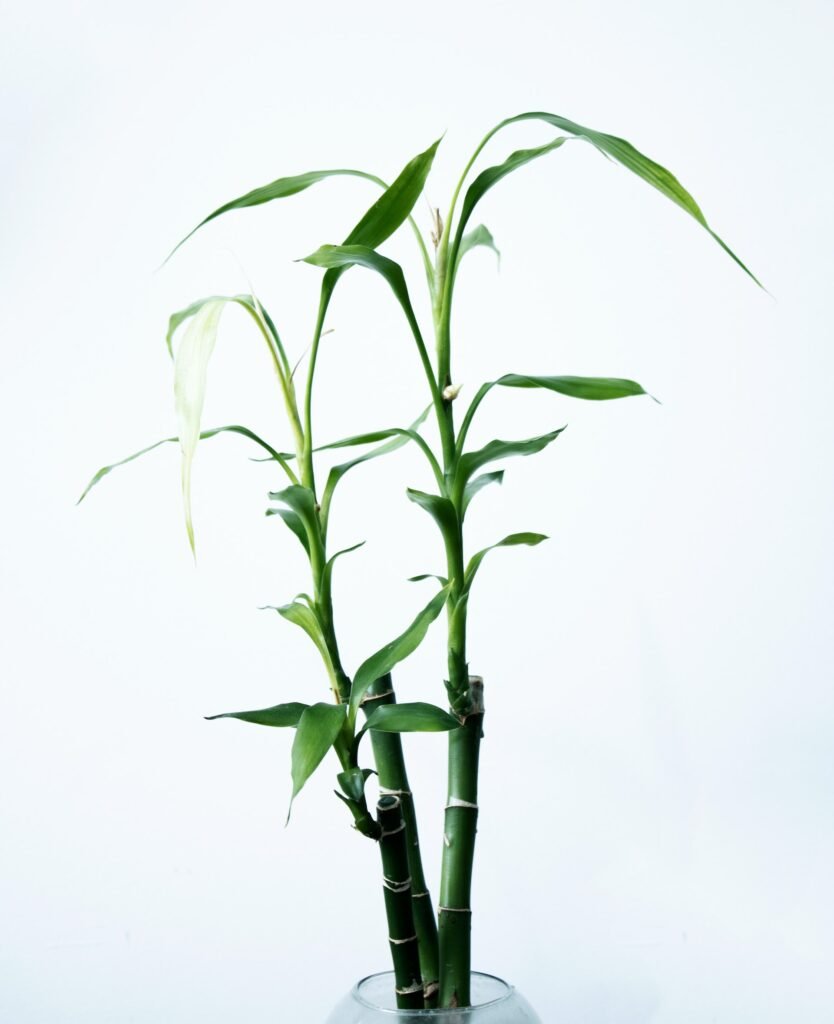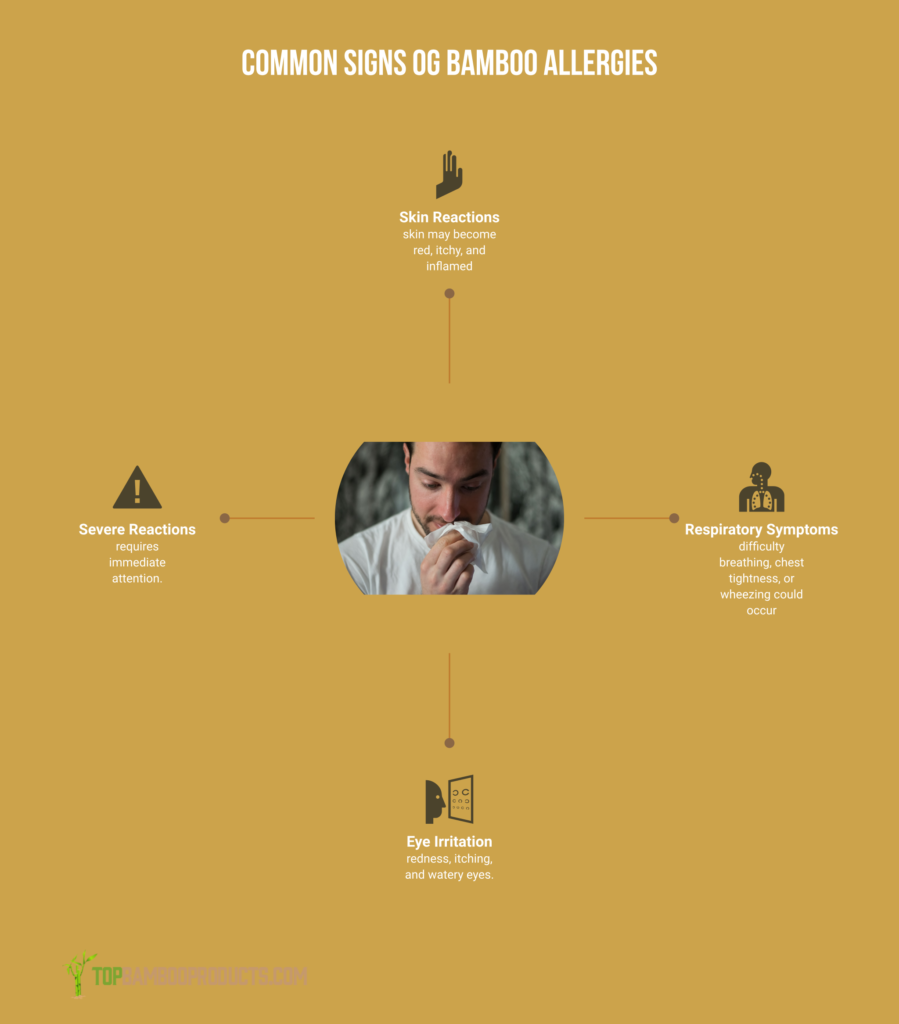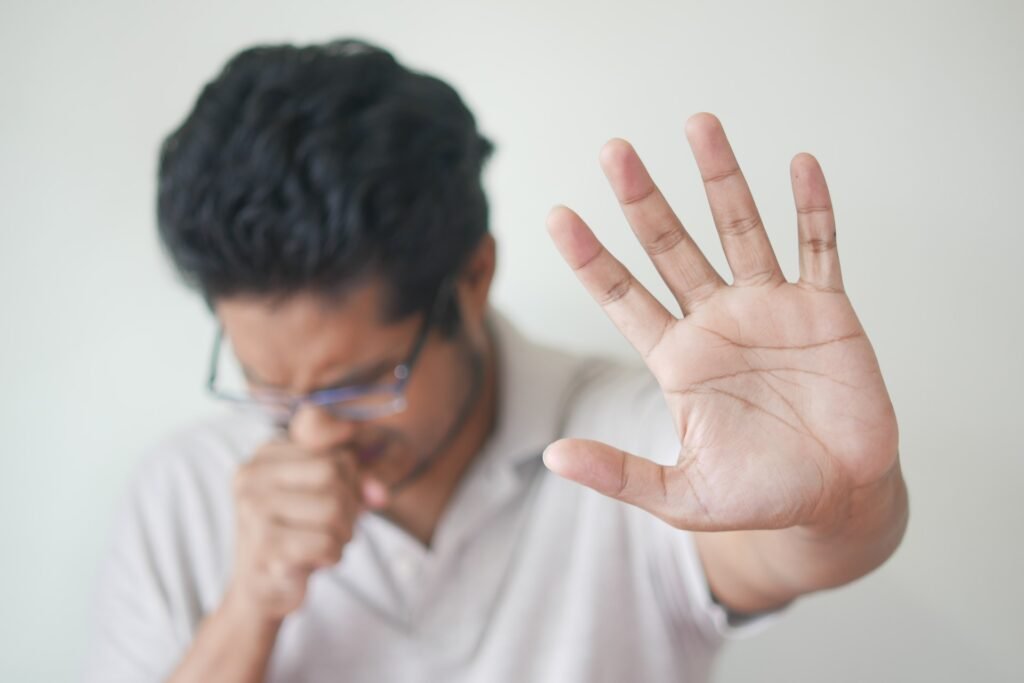Bamboo Allergy Symptoms: What To Know And How To Respond
0Shares
Do you want to know more about bamboo allergy symptoms? Do you ever wonder if that annoying rash on your skin is from your new bamboo sheets or something else entirely? It’s not uncommon to experience bamboo allergy symptoms, but the good news is that awareness and knowledge can go a long way in managing those pesky symptoms.
Bamboo is often used in products such as furniture, flooring, and clothing, so coming into contact with it is almost unavoidable. This allergy can manifest itself in multiple ways, from skin irritation to respiratory issues. So, whether you’re navigating it for the first time or have lived with it for years, knowing how to respond is essential.
This article will explore the bamboo allergy symptoms and give you the tools to address them proactively. So that you can feel confident and comfortable in your daily life.
Brief Overview of Bamboo as a Common Plant and Material

Bamboo is one of the fastest-growing plants in the world, with some species growing up to 91 centimeters in a single day! With over 1,500 species that can be found on every continent except Europe and Antarctica, bamboo is a common plant used in various ways. From building materials to everyday products, bamboo has been a part of human history for thousands of years. Let’s take a closer look at this amazing plant and explore bamboo’s different uses and benefits.
🍃Bamboo as a Building Material
Since bamboo is a strong and durable material that is also lightweight, it is ideal for construction in areas prone to earthquakes and other natural disasters. Bamboo is commonly used for scaffolding, flooring, wall cladding, and roofing. In addition, bamboo can be used to create furniture, kitchenware, and even bicycles.
🍃Bamboo as a Food Source
It is also an important food source for many animals, including the giant panda. The leaves and stalks of bamboo are low in calories and fiber, making them a healthy snack for humans. Bamboo shoots are considered a delicacy used in soups, salads, and stir-fries in some parts of the world.
🍃Bamboo as a Renewable Resource
Bamboo is a highly renewable resource that can grow in almost any climate and soil type. Unlike hardwood trees, bamboo can be harvested every 3-5 years without damaging the plant or the environment. It makes it a sustainable alternative to traditional wood products, which often require clear-cutting of forests and contribute to deforestation and climate change.
🍃Bamboo as a Textile
The bamboo fibers are used to create a variety of textiles, including bamboo rayon, bamboo linen, and bamboo cotton blends. These textiles are soft, breathable, and moisture-wicking, making them a popular choice for clothing and bedding. In addition, bamboo textiles are naturally antibacterial and odor-resistant, making them ideal for use in high-moisture environments.
🍃Bamboo as a Plant
Bamboo is not just a useful material but also a beautiful and unique plant. With its slender stalks and lush foliage, bamboo is a popular choice for landscaping and garden design. Some bamboo species can grow up to 30 meters in height, making them a striking addition to any garden or landscape. Additionally, bamboo plants are believed to have many health benefits, including stress relief and air purification.
These are just a few of the many uses and benefits of bamboo. Now that we understand more about this amazing plant let’s explore the possibility of bamboo allergy.
The Possibility of Bamboo Allergy
So is it possible to be allergic to bamboo? The answer is yes, it is possible. Allergies are caused by an immune system overreaction when exposed to a foreign substance, such as pollen or dust mites. In the case of bamboo allergy, the body mistakes the proteins in bamboo as a threat and produces antibodies to fight off these “invaders.” This leads to an allergic reaction, such as itching and rashes on the skin, sneezing, watery eyes, or difficulty breathing.
It is important to note that bamboo allergy symptoms can vary from person to person and may even be different each time you come into contact with the allergen. In addition, some people may experience mild reactions, while others could have more severe reactions, such as anaphylaxis. Developing a bamboo allergy over time is also possible, so it is important to be aware of the potential risks and take action if necessary.
How to Recognize Bamboo Allergy Symptoms

Recognizing bamboo allergy symptoms is the first step in managing the condition. Here are some common signs to look out for:
📌Skin Reactions
Among the most common symptoms is skin reactions. These may present as hives, rashes, or eczema-like spots on the skin. The skin may become red, itchy, and inflamed in areas that have come into contact with bamboo products.
📌Respiratory Symptoms
Individuals allergic to bamboo might experience respiratory symptoms, such as sneezing, runny nose, and congestion. In more severe cases, difficulty breathing, chest tightness, or wheezing could occur.
📌Eye Irritation
Eye symptoms can include redness, itching, and watery eyes. These symptoms are often similar to those of other types of allergies, such as hay fever.
📌Severe Reactions
In rare cases, individuals might experience severe reactions, such as anaphylaxis. Symptoms include dizziness, rapid heartbeat, difficulty breathing, and loss of consciousness. This is a medical emergency and requires immediate attention.
Remember that bamboo allergy symptoms depend on each individual; not everyone will experience the same symptoms. If you suspect a bamboo allergy, seeking medical advice to confirm the diagnosis and discuss bamboo allergy treatment options is important.
How to Differentiate Bamboo Allergy from Other Allergies
Spring is the season of cherry blossoms, fresh air, and allergies. Allergies become a common issue during spring when the pollen count is at its highest. However, bamboo allergy is not one of the most discussed allergies. Understanding how to identify bamboo allergy symptoms is essential to differentiate them from other allergies. So here’s how to differentiate them.
👉Timing of Symptoms:
Bamboo allergy usually occurs in the summer months, June through August. If your symptoms worsen during this period, you might be allergic to bamboo. On the other hand, other allergies like pollen, pet dander, and dust mites are usually prevalent throughout the year, and their symptoms may not be limited to a particular season.
👉The Severity of Symptoms:
The severity of symptoms is another way to differentiate bamboo allergy from other allergies. Bamboo allergy symptoms can range from mild to severe, including eye irritation, runny nose, and skin rash. However, in severe cases, a bamboo allergy can cause anaphylaxis, a life-threatening reaction. If you experience severe symptoms after prolonged exposure to bamboo, you must seek medical attention immediately.
👉Elimination and Observation:
Elimination and observation are effective ways to identify bamboo allergies. Try eliminating bamboo from your environment, and observe if your symptoms improve. If your symptoms lessen or disappear after removing bamboo, you’re allergic to bamboo. On the other hand, you may also remove other allergens from your environment, and if your condition improves, it means you’re allergic to one of the eliminated allergens.
👉Allergy Testing:
Lastly, allergy testing is an effective way to differentiate bamboo allergies from other allergies. Allergy testing can identify all types of allergens that cause allergic reactions. A small amount of allergen is introduced to the body during allergy testing, and a doctor monitors the body’s reaction. In a few days, the doctor will recommend a proper treatment for your allergy.
Thus, it is difficult to differentiate one from the other. However, identifying bamboo allergies from other allergies is necessary for effective treatment.
Effective Management of Bamboo Allergy

Whether it’s a mild irritation or a more severe reaction, managing bamboo allergy symptoms is crucial for maintaining your well-being. Here are some strategies:
◼️Avoidance
The primary way of managing any allergy is to avoid the allergen. In the case of bamboo allergy, it means staying away from products that contain bamboo fibers. This avoidance strategy can be challenging as bamboo is present in many products. Check labels carefully, and opt for natural fabrics like cotton, silk, or wool. Avoid walking or living in areas with bamboo plants. If you have bamboo flooring at home, consider replacing it with another material. Be cautious about bamboo chopsticks and other utensils, as they may also trigger allergies.
◼️Antihistamines
Antihistamines are medications that work against histamine, which causes allergic reactions. Over-the-counter antihistamines like cetirizine and loratadine can help ease allergic symptoms such as itching, sneezing, and nasal congestion. However, these medications do not work for everyone, and some may experience side effects such as drowsiness, dry mouth, and blurry vision.
◼️Topical Creams
If you have skin reactions such as itching and rashes, topical creams can provide relief. Hydrocortisone is a common anti-inflammatory cream used to soothe skin irritations. Calamine lotion is another option that can help alleviate the itching and discomfort. However, these creams do not address the underlying allergy or provide long-term relief.
◼️Environmental Control
Environmental control measures can help reduce symptoms caused by bamboo allergies. Keeping your home dust-free and well-ventilated can improve air quality and reduce allergen concentration. Invest in a good quality air purifier that can filter out allergens like dust, mold, pollen, and animal dander. Regularly washing your bedding, curtains, and clothes can also help reduce allergens.
◼️Seek Medical Help
If your bamboo allergy symptoms are severe and impact your daily life, seek medical help immediately. Your doctor can conduct allergy tests and prescribe medications like corticosteroids to relieve inflammation. Immunotherapy is also an option for some people, where the patient is given tiny amounts of the allergen to build up their immunity slowly.
Bamboo allergy can be challenging to manage, but with the right strategies and treatments, it’s possible to keep your symptoms under control.
Bamboo Allergies Prevention Strategies

Preventing bamboo allergies can be challenging, but there are ways to minimize the risk. Here are some strategies:
✔️Choose Carefully When Purchasing Bamboo Products.
When purchasing bamboo products, look for items made from high-quality bamboo that’s been processed in a way that limits the chance of allergic reactions. It’s a good idea to avoid products that contain small pieces of bamboo because they can easily be inhaled and cause a reaction in sensitive individuals.
✔️Use Gloves and Protective Clothing
If you’re working with raw bamboo, it’s essential to wear gloves and protective clothing to prevent contact with the bamboo fibers. These fibers can easily penetrate the skin and cause itching, redness, and inflammation. Long sleeves, pants, and a mask can also help protect you from airborne bamboo dust.
✔️Keep Bamboo Products Clean
If you already have bamboo products in your home, such as bamboo mats or blinds, keeping them clean is important. Bamboo fibers can collect dust and allergens, so it’s a good idea to vacuum or wipe down your products with a damp cloth regularly.
✔️Try Alternative Products
If you’re concerned about developing a bamboo allergy, plenty of alternative products exist. Look for natural fibers like cotton, linen, or hemp that are less likely to cause an allergic reaction. You can also opt for synthetic materials if you’re looking for a vegan or cruelty-free option.
Bamboo allergies can be a real concern for many people, but with proper precautions, you can easily protect yourself from allergies to bamboo.
Long-Term Management And Lifestyle Modifications
So, how can you make sure that your bamboo allergy doesn’t worsen in the future? There are some helpful lifestyle modifications and long-term management strategies that can help reduce symptoms of bamboo allergies:
Long-Term Management of Bamboo Allergies
Regular monitoring of symptoms and adjusting treatment plans are crucial for effectively managing bamboo allergies. Keep track of when and where you experience symptoms to help identify potential environmental triggers. Regular check-ups with your allergist or immunologist are also critical. They can assess the effectiveness of your current treatment plan and make necessary adjustments. Immunotherapy or allergy shots may be a viable long-term treatment option for some people. This involves receiving small doses of the allergen, in this case, bamboo, to help your body gradually build immunity. However, this treatment requires close monitoring by a healthcare professional.
Lifestyle Modifications
Modifying your lifestyle can significantly contribute to managing bamboo allergies. Adopt a proactive approach in identifying and avoiding potential sources of bamboo. This could mean opting for different construction materials in your home or being cautious when choosing furniture, clothing, or other products. Consider taking antihistamine medications with you, especially when traveling or visiting unfamiliar places. Lastly, make your environment as allergy-proof as possible. Regular cleaning, air purifiers, and allergen-proof bedding can help minimize contact with bamboo allergens. Remember, the goal is to create a living and working environment that supports your health and well-being.
Living with bamboo allergies can be challenging, but with the proper management and lifestyle modifications, you can control your symptoms and lead a healthy, active life.
Frequently Asked Symptoms
Are there different types of bamboo allergies?
There are different types of bamboo allergies, and the symptoms can vary depending on the type of allergic reaction experienced. The bamboo plant has various parts that can trigger an allergic reaction, including leaves, stems, and sap. The most common type of bamboo allergy is respiratory allergy, characterized by coughing, sneezing, and asthma symptoms. Contact allergies are less common and can cause a rash, itchiness, and hives.
How is a bamboo allergy diagnosed?
A bamboo allergy is diagnosed through an allergy test, either a skin prick or a blood test. Skin prick tests involve pricking skin with allergens to see if there is an allergic reaction. On the other hand, blood tests measure the allergen-specific antibodies in the blood. Your doctor may also do an elimination diet to identify the cause of bamboo food allergy.
Are there any cross-reactivities between bamboo and other allergens?
Bamboo allergy can cross-react with other environmental allergens, such as pollen from grasses, trees, and weeds, leading to the pollen-food syndrome. Foods such as cucumber, melons, apples, and hazelnuts have proteins similar to pollens, and allergens can trigger an allergic reaction. People with bamboo allergies should be aware of these cross-reactivity risks and avoid such foods.
Can children develop bamboo allergies?
Yes! Children, like adults, can develop bamboo allergies. The symptoms of bamboo allergies in children are similar to adults but may sometimes be more severe because of their developing immune systems. Parents should keep bamboo products like furniture, floorboards, or clothing away from their children, especially if they have a history of allergies.
Are there any natural remedies for bamboo allergy relief?
While there is no cure for bamboo allergies, several natural remedies can help alleviate symptoms. Saline nasal sprays and rinses can help clear blocked nasal passages, and steam inhalation can soothe irritated airways. Anti-inflammatory foods such as turmeric, ginger, and garlic can reduce inflammation and alleviate allergy symptoms. Some studies also suggest that honey from local pollen can desensitize the immune system to allergens and reduce allergies over time.
Final Words
After researching bamboo allergy symptoms, I was surprised to discover the wide range of reactions people can have to this seemingly harmless plant. From itchiness and hives to more severe symptoms like difficulty breathing and throat closure. As someone who has always admired the aesthetic of bamboo products, it is disheartening to learn that something as beautiful as a bamboo cutting board or pair of sunglasses could elicit such a negative response from my body.
However, knowledge is power, and recognizing the signs of a bamboo allergy can prevent potentially harmful situations. As with any allergy, it is essential to be mindful of one’s body and seek help if any symptoms arise. Despite the risk of allergy, I am glad to have a greater understanding of bamboo and all its complexities.
0Shares
